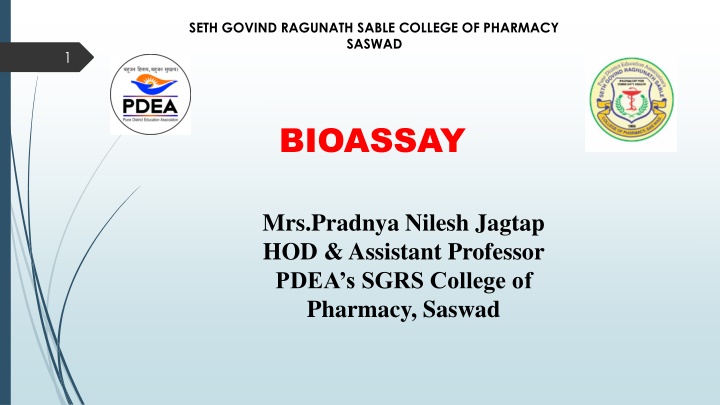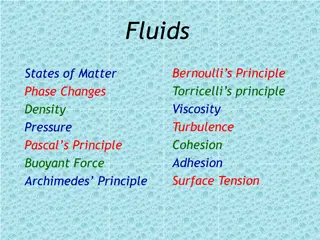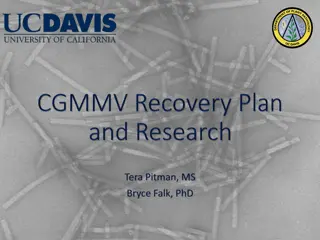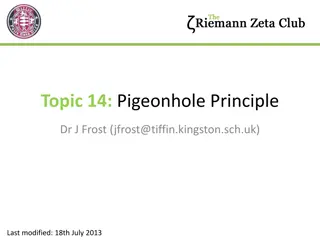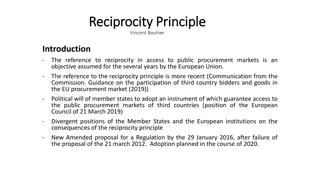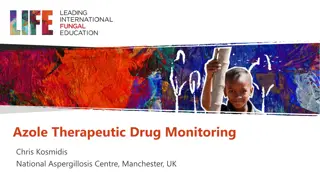Bioassay: Definition, Principle, and Types
This content delves into the definition, principle, and types of bioassays, along with their applications and methods. Learn about qualitative and quantitative bioassays, as well as graded bioassay types.
Download Presentation

Please find below an Image/Link to download the presentation.
The content on the website is provided AS IS for your information and personal use only. It may not be sold, licensed, or shared on other websites without obtaining consent from the author.If you encounter any issues during the download, it is possible that the publisher has removed the file from their server.
You are allowed to download the files provided on this website for personal or commercial use, subject to the condition that they are used lawfully. All files are the property of their respective owners.
The content on the website is provided AS IS for your information and personal use only. It may not be sold, licensed, or shared on other websites without obtaining consent from the author.
E N D
Presentation Transcript
SETH GOVIND RAGUNATH SABLE COLLEGE OF PHARMACY SASWAD 1 BIOASSAY Mrs.Pradnya Nilesh Jagtap HOD & Assistant Professor PDEA s SGRS College of Pharmacy, Saswad
2 INDEX Defination Principle Application Type of bioassay Bioassay of oxytocin Bioassay of digitalis Bioassay of histamine Bioassay of D tubocurarine Bioassay of insulin Bioassay of vasopressin Bioassay of ACTH
BIOASSAY 3 DEFINATION Detection of measurement of the concentration of substance in a preparation using biological method . PRINCIPLE The basic principle of bioassay is to compare the test substance with the international standard preparation of the same and find out how much test substance is required to product a same biol - ogical effect as produced by the standard.
APPLICTION To measure the pharmacological activity or new chemically undefined substance To investigate the function of endogenous mediators To measure drug toxicity and unwanted effect To measure the concentration of drug and other active substance in the blood or other body fluids New drug development Major clinical effectiveness 5
6 TYPE OF BIOASSAY QUALITATIVE BIOASSAY Is used for assessing the physical effects of a substance that may not be quantified , such as abnormal development or deformity. QUANTITIVE BIOASSAY Involve estimation of concentration / potency of a substance by measurement of the biological response it produce.
METHOD OF BIOASSAY 1. QUANTAL 2. GRADED 7 QUNTAL BIOASSAY : In this the response is in the from all or none i.e. Either no response or maximum response. Drug producing quantal effect can be bioassay by end point method. GRADED BIOASSAY : Response is proportional to the dose and response may lie between number response and the maximum response.
Graded bioassay Types: a.Graphical or Interpolation Bioassay b.Matching Point Bioassay c.Bracketing method / direct method d.Multiple point assays Three point Four point Six point 8
GRAPHICAL / INTERPOLATION A log dose response curve is plotted with the standard an a simple graph paper or semi-log paper. The concentration of the test is then read form the graph. 9
Multiplication point Assay Three point method 2 dose of standard + 1 dose of test Four point method 2 dose of standard + 2 dose of test Six point method 3 dose of standard + 3 dose of test 13
18 BIOASSY OF OXYTOCIN Oxytocin is a peptide hormone and Neuropeptide . Oxytocin is normally produced by the paraventricular nucleus of the hypothalamus and released by the posterior pituitary. ROLE OF OXYTOCIN Oxytocin is a natural hormone that causes the uterus to contract. Oxytocin is used to induce labor or strengthen labor contractions during childbirth, and to control bleeding after childbirth. Oxytocin is also used to stimulate uterine contraction in a woman with an incomplete or threatened miscarriage.
PRINCIPLE OF OXYTOCIN Potency is determined by comparing its activity - Depression of BP - Contraction of uterus - Milk Ejection Pressure - Vasopressor activity with standard preparation of oxytocin 19 STANDARD PREPARATION : Consisting freez dried synthetic oxytocin peptide with human albumin citric acid (12.5 units)
METHOD A TEST ANIMAL : COCKEREL (Young male Chicken) Anaethesised cock prolong and constant high B.P 20 Expose gluteus primus muscle and remove popliteal artery and femoral crural vein cannulate the popliteal artery or brachial vein Prepare std solution with saline inject 0.1 -0.5 ml Inject 2 dose of std solution into cannulate vein is record B.P response Dose should cause decrease in B.P
21 Internal between 2 injection between 3-10 min depend on rate at which B.P return normal Dil. Test preparation with saline so as to get same response as standard The ratio between standard and test should be equal Measure all response are calculated result of the assay by std statistical method .
22 BIOASSY OF HISTAMINE Estimation of the concentration /potency of a substance by measuring its biological response in living system . BIOASSY OF HISTAMINE CAN BE DONE BY RECORDING : 1. CRC of isolated guinea pig ileum. 2. BP fall in anaethetised cat or dog.
23 BIOASSY USING GAUINEA PIG ILEUM BIOASSY OF HISTAMINE ON ISOLATED GUINEA PIG ILUM CAN BE DETERMINE BY Matching bioassay Interpolation bioassay Bracketing assay Multiple point assay
24 ILEUM 3/5 cm long part of ileum REQUIRMENTS : Instruments : thermo statically controlled organ bath , chymograph , aerator Physiological solution : Tyrode solution Temperature : 32 c Animal : guinea pig Standard histamine solution
25 preparing standard Take 10 mg of histamine + 10 ml of water (1000ug / ml) Take 0.1 and dilute with 10 ml water ( 10 ug /ml)
26 BIOASSAY USING ANAESTHETISED CAT OR DOG Cat or dog is anaesthestised with chloralosed or barbiturate and prepared for recording of BP Sensitivity is determined by injecting standard solution of 0.05 ,1.0 ,1.5 ug of histamine base per kg body weigh is given for 5 min interval assay is done A fixed dose of standard producing a fall in BP about 20 mm Hg is injected with changing dose of test at regular intervals and matching assay is done
27 BIOASSAY OF DIGITALIS Principle: Potency of the test sample is compared with that of the standard preparation by determining the action on the cardiac muscle. Standard Preparation and Units: The standard preparation is a mixture of dried and powdered digitalis leaves (1 unit = 76 mg.) Preparation of Extracts: Exact amount of the powder is extracted with dehydrated alcohol in a continuous extraction apparatus for six hours. The final extract should contain 10 ml. (5 ml. alcohol + 5 ml. water) per 10 g. of digitalis powder. It should be stored in between 5 0C and 5 oC.
PIGEON METHOD oMinimum 6 pigeons are used for testing each sample. o The weight of the heaviest pigeon should not exceed twice the weight of the lightest pigeon. o Food is withheld 16-28 hours before the experiment. o Pigeons are divided on the basis of their sex, weight and breed, into two groups. o They are anaesthetized with anesthetic ether. o One side of the wing is dissected and the alar vein is cannulated by means of a venous cannula. Dilutions are made with normal saline. o The test sample and standard sample is infused through cannula In pigeons, stoppage of heart is associated with a characteristic vomiting response called emesis . o The milk from the crop sac of pigeons is being ejected out. This may be taken as the end point response of digitalis. The lethal dose per kg. of body weight is determined for each pigeon. o The potency of the test sample is determined by dividing the mean lethal dose of standard by the mean lethal dose of the test sample. 28
BIOASSAY OF D-TUBOCURARINE 29 Rabbit Head-drop Method : Principle: d-Tubocurarine hydrochloride is injected into the marginal vein of a rabbit s ear till the rabbit s neck muscles are relaxed such that the animal cannot hold its head up. The total amount of test sample required to produce the endpoint is compared with the total amount of the standard sample required to produce similar endpoint. Selection of Rabbits: Rabbits weighing 2 kg. are used. Animals should be free from disease, obtained from a healthy colony and should be accustomed with the experimental procedure. Experimental Procedure: - Rabbit is placed in a holder with its head protruding outside. o The head should be freely movable. - Minimum 8 rabbits are used.
They are divided into two groups each containing 4 rabbits. o First group will receive standard sample and the second group will receive the sample under test. o d-Tubocurarine solution is injected at a constant speed by infusion apparatus through the marginal vein. o Injection should be given at a rate of 0.4 ml/min and should take about 10 min. Dose 0.012% w/v in saline. o Infusion is continued till the rabbit will not be in a position to hold its head erect or there will be no response by focusing light on the eyes. o Rabbits recover immediately from the effect of curarization. o During the experiment there is a possibility of respiratory embarrassment which is treated by injecting neostigmine, methyl sulphate (0.05 mg.) and atropine sulphate immediately through the marginal ear vein. 30
o Cross-over test is carried out to minimize biological error due to animal variation. o Those rabbits which received the standard sample on the first day will be given test sample on the second day of experiment and vice versa. o Mean dose which produces head drop of the test sample is compared with the mean dose of standard preparation. 31
32 Insulin was discovered in 1921, which helped millions suffering from type- 1 diabetes . It is a hormone made in pancreas, special cells call beta cell produce insulin When a person suffer from type-1 diabetes the capability of these cells is lost Most people now a days use human insulin or insulin analogs.. Its is produced by bacteria (lilly) or by yeast (Novo-Nordisk) by using genetic engineering .
BIOASSAY OF INSULINE 33 Standard preparation and unit: It is pure, dry and crystalline insulin. One unit contains 0.04082 mg. This unit is specified by Ministry of Health, Government of India and is equivalent to international unit. Preparation of standard solution: Accurately weigh 20 units of insulin and dissolve it in normal saline. Acidify it with HCl to pH 2.5. Add 0.5% phenol as preservative. Add 1.4% to 1.8% glycerin. Final volume should contain 20 units/ml. Store the solution in a cool place and use it within six months. Preparation of test sample solution: The solution of the test sample is prepared in the same way as the standard solution.
Rabbit method 34 Selection of rabbits: They should be healthy, weighing about 1800-3000 gm . They should then be maintained on uniform diet but are fasted for 18 hrs. before assay. Water is withdrawn during the experiment. Standard and Sample Dilutions: These are freshly prepared by diluting with normal NaCl solution so as to contain 1 unit/ml. and 2 units/ml. Doses:The dose which can produce suitable fall in blood sugar level is calculated for the standard. Principle:The potency of a test sample is estimated by comparing the hypoglycemic effect of the sample with that of the std. preparation of insulin. Any other suitable method can also be used.
Experimental Procedure: Animals are divided into 4 groups of 3 rabbits each. The rabbits are then put into an animal holder. They should be handled with care to avoid excitement. 35 First part of the Test: A sample of blood is taken from the marginal ear vein of each rabbit. Presence of reducing sugar is estimated per 100 ml. of blood by a suitable chemical method. This concentration is called Initial Blood Sugar Level . The four groups of rabbits are then given sc. injections of insulin as follows: 12 RABBITS 3 3 3 3 standard standard test sample test sample Dilution Dilution Dilution Dilution (1) (2) ( 1) (2)
From each rabbit, a sample of blood is withdrawn up to 5 hrs. at the interval of 1 hr. each. Blood sugar is determined again. This is known as Final Blood Sugar Level . 36 Second part of the test (Cross over test) : The same animals are used for the second part. The experiment can be carried out after one week. Again they are fasted and initial blood sugar is determined. The grouping is reversed, that is to say, those animals which received the standard are given the test and those which received the test are now given the standard. Those animals which received the less dose of the standard are given the higher dose of the test sample and vice-versa. This test is known as Twin Cross Over Test .
37 RAT DIAPHRAGM METHOD Sprague Dawley rats weighing 70 100 g are used. The animals are sacrificed during anesthesia and the diaphragms still attached to the rib cages are carefully removed, released from the rib cages and adhering connective and fat tissues, washed in PBS, spread out and divided into two equal pieces as described by M ller and coworkers (1994). For assaying the effects of insulin/compounds/drugs, the hemidiaphragms are incubated in KRH buffer gassed with carbogen (95% O2 /5% CO2) in the presence of 5 mM glucose Epididymal fat pad of rats Insulin-like activity can be measured by the uptake of glucose into fat cells. Adipose tissue from the epididymal fat pad of rats has been found to very suitable.
38 The difference of glucose concentration in the medium after incubation of pieces of epididymal rat adipose tissue or measured oxygen consumption in Warburg vessels, Radiolabelled 14C glucose, the 14CO2 is trapped and counted. The concentration is determined by immuno- assay
Bioassay of ACTH/ Adrenocorticotropic Hormone/ corticotropin 39 Bioassay of ACTH ACTH (Adrenocorticotropic hormone, corticotropin) is polypeptide tropic hormone (39 amino acids) secreted by the anterior pituitary gland. ACTH stimulates the production of cortisol, a steroid hormone important for regulating glucose, protein and lipid metabolism, suppressing the immune system response, and helping to maintain blood pressure.
Bioassay of ACTH Official Preparations Corticotropin injection: Is a sterile solution , in a suitable diluent, of the polypeptide from the pituitary glands of mammals. Potency range should be 80.0 120.0 % of USP cartiotropin units. Corticotropin for injection, antimicrobial agent. Repository corticotropin injection is corticotropin in a sterile solution of partially hydrolyzed gelatin and is intended for subcutaneous and intramuscular use. This solution has been adopted as the reference standard for the bioassay. 40
. Packing : Preserve in single-dose or multiple-dose containers of Type-1 glass. Storage: 41 Store in cold place. Labeling: Injection recommends intravenous administration. Purpose and rationale This is a historical assay method Administration of pituitary ACTH decrease the ascorbic acid present in the adrenals. The depletion of adrenal ascorbic acid is a function of the dose of ACTH administered. This relationship has been used for a quantitative assay of ACTH.
Procedure 42 Male Wistar rat (100-200 g) are hypophysectomized (pituitary gland removed by surgery) one day prior to the test. For one test with 3 dose of test preparation and standard Number of hypophysectomized rats required: at least 36 (preferably 60) Solution: Five units of test or standard dissolved in 0.25 ml of 0.5% phenol solution and diluted with 8.1 ml of 15% gelatin solution (Now 0.5 ml contain 300 mu ACTH). (Solution A) Three ml of solution A diluted with 6 ml gelatin solution. Now concentration reduced to 100 mu ACTH/ 0.5 ml (solution B) Again 3 ml of solution B diluted with 6 ml of gelatin solution, the resulting solution contains 33 mu ACTH/ 0.5 ml
Procedure Cont., The hypophysectomized rats are randomly distributed in to six groups. Each rat receives subcutaneous 0.5 ml of the various concentrations of test or standard. Three hours after injection, the animals are anesthetized and both adrenals removed, freed from extraneous tissue and weighed. The rats are sacrificed and the scull opened to verify completeness of hypophysectomy. The adrenals are homogenized in glass tubes contains 200 mg pure sand and 8.0 ml of 4% trichloroacetic acid and the ascorbic acid determined.. The potency ratio including confidence limits is calculated with the 3 + 3 point assay. 43
Ascorbic acid determination Reagents 44 0.02% ascorbic acid solution 85 % sulfuric acid (9N H2SO4 ) 0.02 g/ml of dinitrophenolhydrazine in 9N H2SO4 0.06 g/ml of thiourea are dissolved in distilled water Charcoal Preparation of 0.02% ascorbic acid solution 100 mg L-ascorbic acid are dissolved in 100 ml of 4% trichloroacetic acid (1mg/ml solution) (Solution A= 1 % solution) 2 ml of Solution A diluted in 10 ml of 4% trichloroacetic acid to achieve a 0.2% ascorbic acid solution (solution B) 1 ml of solution B diluted in 10 ml of 4% trichloroacetic acid to achieve a 0.02% ascorbic acid solution (solution C)
Preparation of other solutions - Sulfuric acid (85%) is obtained by adding 900 ml concentrated sulfuric acid to 100 ml distilled water. - Two g dinitrophenolhydrazine are dissolved in 100 ml 9 N H2SO4 (75 ml distilled water and 25 ml concentrated sulfuric acid). - Six g thiourea are dissolved in 100 ml distilled water. Calibration - Trichloroacetic acid (4%) is added to 0.0, 0.5, 1.0, 2.0, 3.0, 4.0, 6.0, 8.0 ml of the 0.02% ascorbic acid solution (solution C) and 1.0, 1,5 and 2.0 ml of the 0.2% ascorbic acid solution to reach a final volume of 8.0 ml (Solution B). -100 mg charcoal is added to each sample and thoroughly mixed by shaking for 1 min. After 5 min the solutions are filtered. -An aliquot of 0.1 ml of the 6% thiourea solution is added to 2.0 ml of the filtrate followed by 0.5 ml dinitrophenylhydrazine solution. 45
The mixture is shaken and heated for 45 min at 57C in a water bath. Calibration cont., The solutions are placed in an ice-cold water bath and with further cooling 2.5 ml of the 85% sulfuric acid are added. The calibration curve is established at a wave length of 540 mm using the solutions without ascorbic acid as blank. 46
Corticotrophin Injection USP 47 Various dilutions of standard and test ACTH is prepared at geometric series such as 1:2:4 or 1:3:9 at the rage of 10 to 300 milli-units. Either gender of rats (weighing 80- 180 g) is used for the experiment. Rats are divided into six groups of each six and three groups assigned for standard and other three groups in test Prior (48h) to the injection of ACTH, animals are anesthetize and remove the hypophysis. All the animals are given subcutaneous injection of assigned standard/ test ACTH injection. Three hours after injection, rats are anesthetized, both adrenal glands are removed, weighted, stored in metaphosphoric acid solution for determination of ascorbic acid.
BIOASSY OF VASOPRESSIN Its is a peptide hormone that is secreted by the posterior lobe of the pitutary gland , which constrict blood vessels , raise blood pressure ,stimulates intestinal motility , and reduce the excretion of urine. Its has vasopressor action i.e can stimulate contraction of arteries and capillaries . Hence the name vasopressin STANDARD PREPARATION It is a dried acetone extraction of posterior lobes of pituitary gland oxen or other suitable preparation Standard unit : Specific pressor activity corresponding to the yielded by 0.0005 gm of standard preparation (20 units /ml ) 48
49 METHOD Anaesthetize healthy cat with volatile anaesthetic agent Insert a tracheal tube for artificial respiration Expose spinal cord from behind by removing second cervical vertebrae Destroy brain by passing suitable instrument through foramen magnum Start artificial respiration through tracheal tube and leave animal for an hour to remove anaesthetic effect Cannulate carotid artery for B.P measurement and femoral vein for injection of drug solution Maintain normal B.P at 50-100 Select dose of test and standard inject 0.05 -0.1 units at 30 min. interval Record maximum rise B.P .IN response to each dose
50 THANK YOU
